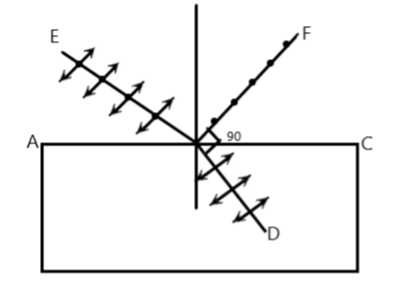Question
Question: a) Show, giving via suitable diagram, how unpolarized light can be polarized by reflection. (b) T...
a) Show, giving via suitable diagram, how unpolarized light can be polarized by reflection.
(b) Two polaroids P1 and P2 are placed with their pass axes perpendicular to each other. Unpolarised light of intensity I is incident on P1. A third polaroid P3 is kept in between P1 and P2 such that its pass axis makes an angle of 60∘ with that of P1. Determine the intensity of light transmitted through P1, P2 and P3
Solution
The vertically vibrating of light is transmitted through a reflective surface, while the horizontal vibration is reflected. When an unpolarized light passes through the first polaroid, the intensity of the plane polarized light is half that of the incident unpolarised light.
Formula used: We will be using the following formula,
I=2I0 where I is the intensity of the polarized light transmitted through the first polaroid and I0 is the intensity of an unpolarized light. I=I0cos2θ where I is the final intensity of the transmitted polarized light, I0 is the initial intensity a plane polarized light, and θ is the angle the direction of polarization and the pass axis of the polaroid.
Complete Step-by-Step Solution:
a)

When unpolarized light E strikes a reflective surface AC, the vertically vibrating component of light becomes refracted into the block while the horizontal
(parallel to the surface) vibrating light F is reflected. When the angle of incidence is increased to an extent such that the angle between the reflected and the refracted ray is 90∘, a perfectly horizontally polarized light is reflected.
b) When the unpolarised light strikes the first polaroid, the resulting intensity becomes half that of the intensity of the unpolarized light. Therefore,
I1=2I0 where I1 is the intensity of the polarized light transmitted through P1.
The polarized light strikes a second polaroid P3 which is at angle 60∘ to P1. Thus, intensity of the transmitted light is given by
I3=I1cos260
⇒I3=I1(21)2=4I1
where I3 is the intensity of the light transmitted through P3.
Since I1=2I0, then
I3=2I0×41=8I0
Finally, the intensity through P2 is given as
I2=I3cos230 (angle of P3 with P2 will be 90∘−60∘)
Hence,
I2=8I0cos260=8I0(23)2=8I0×43
∴I2=323I0
Note: In application, the arrangement of polaroids as done in (b) is used when we need to rotate the direction of polarization by 90∘like from vertical axis to horizontal axis. Without the polaroid P3 all light transmitted through P1 will be cut off by P2since I2=I0cos290∘=0. But when the polaroid P3is placed, it allows some light to pass through P2 and with the direction rotated by 90∘.
